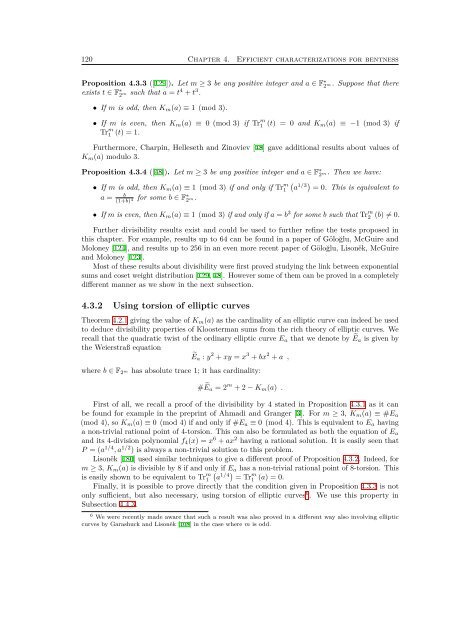here - Sites personnels de TELECOM ParisTech - Télécom ParisTech
here - Sites personnels de TELECOM ParisTech - Télécom ParisTech
here - Sites personnels de TELECOM ParisTech - Télécom ParisTech
Create successful ePaper yourself
Turn your PDF publications into a flip-book with our unique Google optimized e-Paper software.
120 Chapter 4. Efficient characterizations for bentnessProposition 4.3.3 ([129]). Let m ≥ 3 be any positive integer and a ∈ F ∗ 2m. Suppose that t<strong>here</strong>exists t ∈ F ∗ 2 such that a = m t4 + t 3 .• If m is odd, then K m (a) ≡ 1 (mod 3).• If m is even, then K m (a) ≡ 0 (mod 3) if Tr m 1Tr m 1 (t) = 1.(t) = 0 and K m (a) ≡ −1 (mod 3) ifFurthermore, Charpin, Helleseth and Zinoviev [48] gave additional results about values ofK m (a) modulo 3.Proposition 4.3.4 ([48]). Let m ≥ 3 be any positive integer and a ∈ F ∗ 2m. Then we have:• If m is odd, then K m (a) ≡ 1 (mod 3) if and only if Tr m 1a =b(1+b)for some b ∈ F ∗ 4 2 m.(a1/3 ) = 0. This is equivalent to• If m is even, then K m (a) ≡ 1 (mod 3) if and only if a = b 3 for some b such that Tr m 2 (b) ≠ 0.Further divisibility results exist and could be used to further refine the tests proposed inthis chapter. For example, results up to 64 can be found in a paper of Göloğlu, McGuire andMoloney [124], and results up to 256 in an even more recent paper of Göloğlu, Lisoněk, McGuireand Moloney [123].Most of these results about divisibility were first proved studying the link between exponentialsums and coset weight distribution [129, 48]. However some of them can be proved in a completelydifferent manner as we show in the next subsection.4.3.2 Using torsion of elliptic curvesTheorem 4.2.1 giving the value of K m (a) as the cardinality of an elliptic curve can in<strong>de</strong>ed be usedto <strong>de</strong>duce divisibility properties of Kloosterman sums from the rich theory of elliptic curves. Werecall that the quadratic twist of the ordinary elliptic curve E a that we <strong>de</strong>note by Ẽa is given bythe Weierstraß equationẼ a : y 2 + xy = x 3 + bx 2 + a ,w<strong>here</strong> b ∈ F 2 m has absolute trace 1; it has cardinality:#Ẽa = 2 m + 2 − K m (a) .First of all, we recall a proof of the divisibility by 4 stated in Proposition 4.3.1 as it canbe found for example in the preprint of Ahmadi and Granger [3]. For m ≥ 3, K m (a) ≡ #E a(mod 4), so K m (a) ≡ 0 (mod 4) if and only if #E a ≡ 0 (mod 4). This is equivalent to E a havinga non-trivial rational point of 4-torsion. This can also be formulated as both the equation of E aand its 4-division polynomial f 4 (x) = x 6 + ax 2 having a rational solution. It is easily seen thatP = (a 1/4 , a 1/2 ) is always a non-trivial solution to this problem.Lisoněk [180] used similar techniques to give a different proof of Proposition 4.3.2. In<strong>de</strong>ed, form ≥ 3, K m (a) is divisible by 8 if and only if E a has a non-trivial rational point of 8-torsion. Thisis easily shown to be equivalent to Tr m ( )1 a1/4= Tr m 1 (a) = 0.Finally, it is possible to prove directly that the condition given in Proposition 4.3.3 is notonly sufficient, but also necessary, using torsion of elliptic curves 6 . We use this property inSubsection 4.4.3.6 We were recently ma<strong>de</strong> aware that such a result was also proved in a different way also involving ellipticcurves by Garashuck and Lisoněk [108] in the case w<strong>here</strong> m is odd.
















